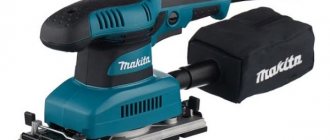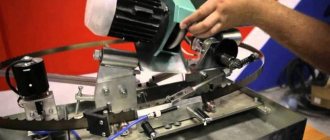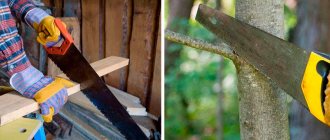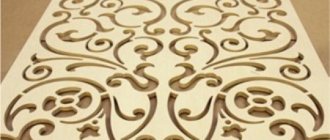0
10535
31.03.2014
A wood sander is an indispensable tool when performing finishing work in a country house. Using a sanding machine allows you to speed up the process of sanding and polishing wooden surfaces - wall cladding, floors, furniture, decorative elements. Wood sanders are convenient and compact, allowing you to perform high-quality leveling of any wooden surface.
Wood sander
There are several main types of sanders for household use; their different designs and operating principles determine their purpose. For construction and repair, carpentry and carpentry work, the following types of grinding machines are used:
- Belt sanders (LSM) are tools for aggressive and rough processing of wooden, plastic, and metal surfaces.
- Vibratory grinders (VSM) allow for softer processing due to circular movements with small amplitude. The grinding surface of the orbital sander has a rectangular shape, which makes it easier to process corners.
- A type of flat vibratory sander is a delta sander; it is distinguished by a triangular shape of the sole. The delta sander is convenient for processing small and hard-to-reach areas, corners, recesses and recesses.
- An eccentric sander refers to a tool that allows you to grind a surface to a polished state due to a combination of rotational and oscillatory movements of the sanding pad. But an eccentric sander is not suitable for processing small surfaces and internal corners.
Types of grinding machines
Purpose and scope
Despite such a wide variety, they all perform almost the same functions:
- preparing the surface for further processing (removing old paintwork, removing natural blue and darkening);
- rough processing;
- grinding;
- polishing;
This tool is widely used both in solving production problems and in the home workshop. Certain types of angle grinders are capable of brushing wood. Depending on the quality of processing, an abrasive tool is selected.
What is sandpaper
Sanding paper is a combined material that consists of:
- The basis of sandpaper is most often paper or fabric.
- Abrasive is a grain that is applied to a substrate using glue or resin.
Manufacturing
Sandpaper production was first started in China in the 13th century. Craftsmen glued river sand of various sizes, crushed shell rock, and plant seeds to parchment using agar-agar or starch glue. Later they came up with the idea of using crushed glass as an abrasive, hence the appearance of “glass paper.”
Serial production of sandpaper began in London in 1833, then began to spread throughout the world, technology improved, and today we see a variety of types of this product.
Production stages:
- The paper base or fabric is impregnated with polymers, most often rubber latex.
- Glue heated to 30...50C is applied to the prepared base.
- The abrasive of the required fraction is applied using the bulk method.
- The semi-finished product is sent to the oven for drying. The temperature depends on the type of glue, grain fraction and other factors.
In this way, you can make low-quality sandpaper at home using thick cardboard, crumbs from an abrasive wheel or crushed glass, sand.
Release form
Finished products are stored by stacking sheets or rolling them into rolls. Sheet fabrics have sufficient rigidity, so they are difficult to bend. Sandpaper in rolls is more compact to store, its fraction and grain size are smaller than that of sheet sandpaper.
Other release forms:
- The abrasive mesh is a sparse sheet with fixed grain. When sanding, even the smallest dust particles pass through the material and do not become clogged in the pores. This working method is called “dust-free sanding”.
- Abrasive wheels are fine-grained sandpaper cut to the shape of attachments for mechanical devices. Its purpose is to clean the metal surface from rust and remove old coating.
- Sandpaper of different grits, cut to the shape of the attachment for power tools with Velcro fastening or to the holes made.
- Sanding belts intended for threading into sanding machines and machines.
Marking
Sandpaper markings indicate the fraction and concentration of the abrasive. Domestic GOST 3647-80 determines the number of grains of different sizes per 1 square unit, but this classification is considered outdated. Today, sanding paper complies with international ISO standards; this designation can be found on the back of the product. It should be noted that the data of the old GOST and the values of international standards overlap with each other. Their correspondence can be seen in the table.
The main difference between the old and new standards is the different movement of numbers in the markings:
- In GOST 3647-80, the values of grain size and density are reduced, which is quite logical;
- In the new ISO 6344 standard (GOST 52318-2005), the product number increases with decreasing value in the marking.
Decoding grain size
The letter "P" in the designation indicates the grain size. The larger the value behind the letter, the finer the skin fraction. P400 is a known zero. P600...P2500 have small fractions and an almost smooth surface; their grain size is not so noticeable to the touch. This type of sandpaper is used for final polishing in industry.
In the old GOST, things were different. Using 10-N as an example: the first number means that an abrasive of a size corresponding to a sieve with a mesh of 100 microns is applied to the surface of the product. The lower the indicator, the smaller the screening size.
Other designations
Types of sandpaper differ in the composition of the base and the properties of the grains. This information is also reflected in the product labeling.
- The letter “L” indicates the sheet form of the product. Rolled is not indicated in any way.
- The letter "M" stands for waterproof sandpaper.
- The product marked “P” is intended for grinding dry products without contact with moisture.
- “1” is an abrasive for soft surfaces, “2” is for hard surfaces.
To select emery for a certain type of work, you should take into account not only the main classification, but also the information provided, which is contained on the back of the sheet.
Design and principle of operation
Despite the variety of types of grinding machines, they are based on one operating principle. Converting the rotational motion of an electric motor into translational or rotational (for an abrasive wheel) motion. Depending on the power of the machine (electric motor), design features, you can determine the tree that can be effectively used on a given device. Therefore, any device can be considered as a set of standard elements:
- Electrical engine;
- Control block;
- rotation transmission system;
- controlled element with applied abrasive;
- power cable;
- optional equipment.
The size and weight of the machine is determined by the engine power, the weight of each element and the number of additional equipment. The more powerful the engine, the wider the capabilities of the grinder. As an additional equipment, a vacuum cleaner can be used to remove wood dust and small particles from the sanding material. This increases operational safety and significantly improves the working conditions around the unit.
The operating principle depends on the type of grinding machine. They are mainly of four types:
- tape;
- vibration;
- eccentric.
In tape machines I use a belt with granite chips applied to it. Its edges are fastened together. It is placed on the motor shaft and secondary shaft, which ensure its rotation at a given speed. The engine power of such devices varies from 500 W to 1200 W. Some models are equipped with a speed control device. This allows you to select the most optimal treatment mode for the wooden surface (this is especially important for different wood densities). The width of the belt and its linear length depend on the dimensions of the installed shafts. The wider it is, the more processing possibilities there are. An important indicator in this case is not only the length of the tape, but also the degree of its tension. The tightness of the tape and the quality of processing depend on this parameter. The ability to quickly replace the belt with another one with a finer or coarser abrasive significantly expands the capabilities of such devices. Many draw frames are equipped with waste collection devices. Some are equipped with special vacuum cleaners.
Such machines are mainly manufactured in a stationary version. A grinder can be considered as an example of such units. It is used mainly for preliminary (rough) processing of wood and prepared parts, and removal of old paint and varnish coatings.
Vibrating machines use the principle of converting circular rotation of the motor shaft into circular movements of the grinding surface with small amplitude oscillations. In such devices, the abrasive surface has the shape of a rectangle. Thanks to the low rotation speed and low vibration, they produce soft sanding of the pre-treated wood surface. A separate type of vibration machines are delta grinders. They have a triangular-shaped sole on which the abrasive material is located. Thanks to this shape, they can be used to process various sizes, recesses, recesses, corners and internal turns.
For processing surfaces with high precision and polishing wooden surfaces, eccentric or orbital sanders are used. High quality processing is achieved through slow oscillatory-rotational movements. The main limitation of the use of such sanders is their inability to process small parts and internal corners.
Types of grinding machines
Currently, a fairly large number of types of grinding machines have been developed. All types of grinding machines are divided into the following categories:
- tape;
- surface grinding;
- eccentric;
- delta grinding;
- brushes;
- renovators;
- grinders.
All these electric tools can be divided into two categories: hand-held grinders and stationary ones. It can be manual or stationary. Each of the listed types is capable of solving, in addition to basic processing tasks, also highly specific ones.
The eccentric unit is a manual operation and is used mainly for final polishing. Such machines are also called orbital. This is due to the nature of rotation of the abrasive sheet and the technique of its use.
Vibratory grinding machines are considered a separate type. They differ from each other in the way they attach the sanding sheet. It can be attached using a special fixation mechanism located on both sides of the sole or using the so-called Velcro. A sheet of sandpaper is applied to it, and it is securely fastened. To ensure the removal of generated dust, holes are made in the sole through which it enters the dust collector. A variety of such units are angle or delta grinders. Their difference is the shape of the sole, which has a triangular appearance.
Straight face grinders belong to the class of hand tools. Their distinctive feature is the way the grinding attachment is placed. It is mounted on a spindle located along the longitudinal axis. The nozzle is a circle with the required size of abrasive chips. This circle is rigidly fixed to the motor shaft. Such machines can operate from a standard electrical network or built-in batteries.
Factors to consider
If you need to process a wooden surface, then you need to choose the optimal device to do it correctly; you should take into account several important criteria:
| Type of product being processed | It can be anything: load-bearing elements made of timber or logs, finishing made of lining, block house or boards, window and door blocks, furniture elements, decorative items and much more. Naturally, each type of product has its own optimal tool option, with which you can achieve the best quality of work with the least amount of time and effort. |
| Sanding quality | Another important factor, because in some situations it is necessary to smooth out large irregularities, and in others it is necessary to bring the surface to an ideal state. Therefore, before sanding wood, you need to stock up on the necessary consumables - discs or brushes with different grain sizes. |
| Scope of work | Smaller projects can be handled by hand, while larger projects will require the use of power tools, otherwise they can take weeks or even months to complete. If you decide to sand the wood yourself, the easiest way is to rent the necessary equipment; the price of this service is low. |
For large volumes of work, you will need a sanding cup for wood - its service life exceeds all other options tens of times
How to choose
When choosing a sanding machine for processing wooden products, you must clearly understand the entire list of operations that will need to be performed. Typically, a wood sander is selected based on two groups of criteria:
- technical;
- are common.
The first category includes the following characteristics:
- engine power installed in the machine (the larger it is, the higher the performance);
- rotation speed of the grinding element (belt or wheel) - the quality of the resulting surface depends on it;
- the presence of a device for adjusting the speed of revolutions (this expands the functionality);
- requirements for electrical network parameters;
- the presence of additional systems that improve working conditions (for example, a built-in dust removal system or an independent vacuum cleaner).
General requirements for wood cutting machines include:
- length of the power cable (ease of use depends on this and expands the possibilities for moving it);
- ergonomics of the body and handle (with the most successful design, rapid fatigue is not observed, which ultimately affects safety);
- ease of operation (all buttons and switches for controlling the grinding machine modes should be within easy reach and be easy to turn on, without unnecessary effort);
- it is desirable to have a “soft start” function, that is, after turning on the unit, the engine gradually gains speed (this allows you to stop processing in a timely manner in an unforeseen situation);
- the presence of a protective system against overheating (it will protect the owner during operation and keep the machine in good condition);
- maximum total weight (this indicator is especially important for hand-held wood sanders);
- for machines with sanding tape or overlay sheets of paper, there must be reliable clamps for fastening.
Using these criteria, you can choose the right sanding machine that will solve all the woodworking tasks. If there is a need for high productivity, it is better to choose professional models. Unlike household machines, which are capable of working continuously for about three hours with a subsequent break, professional machines are designed to process wooden products for 8-12 hours. During the entire period they retain the declared characteristics.
When carrying out simple one-time processing operations, you can opt for simple machines or use special attachments for an electric drill.
What is a sander?
For the convenience of processing internal and external surfaces of wood, plastic, metal or stone, a special grinding machine is used. This power tool is designed to make the product smooth, that is, to reduce the roughness coefficient of its surface. The device is actively used in the process of car body repair, construction work, wall and floor repair, and furniture restoration. A grinding machine significantly speeds up manual labor and improves the quality of the work performed.
Operating rules
All grinders are classified as electrically hazardous tools. In order to use such units correctly, existing rules must be carefully followed. They can be divided into two categories:
- Rules for using a specific sample of a grinding machine.
- Safety precautions when working with tools.
The rules of use are defined in the operating instructions for a specific sample. To work correctly and achieve the best results you need to:
- set the optimal rotation speed;
- select an abrasive tool (wheel, belt, attachment) of the required grain size;
- connect additional devices, for example, a dust collector (if available);
- follow the switching sequence;
- when processing small parts, it is more advisable to move the part along the abrasive tool, and not vice versa;
- use only a network with a verified voltage rating;
- promptly replace abrasive materials;
- do not make sudden movements.
The safety rules for wood sanders are similar to those for other sanding devices. The main purpose of these rules is to ensure user safety. The main sources of danger in such devices are: high voltage, rotating parts, dust from the workpiece. The list of such rules includes:
- use the grinder only with tested electrical components (cable, plug, control device, rotation regulator);
- use only reliable abrasive tools (prevent its destruction and damage to open parts of the body);
- carefully monitor the surface being processed and avoid arbitrary chipping, especially at the edges of the part;
- monitor the state of the surrounding air and increased dust content;
- do not allow work without protective equipment that reduces noise levels.
To solve these problems when working on wood with grinding machines, the user should be provided with safety glasses, headphones, a respirator and thick work clothing.
Making a grinder from a grinder
Many may say that the “grinder” is the same as an angle grinder, but there are some subtleties hidden here. It should be borne in mind that the angle grinder has very high speeds and often quite a decent weight. To polish a surface with a grinder, you need to have considerable experience in this matter and use special polishing discs and circles. The grinder has much lower engine speed and weight. To operate a factory grinding machine, no specific experience or skill is required.
You can independently make a good grinder from an angle grinder, which is not inferior in its parameters to a factory machine, only by modifying its electrical circuit, by installing the regulator at lower speeds and by using special grinding attachments.
Delta grinding
This is the same eccentric machine, but it looks like an iron. Just like in VSM, here, with the help of oscillatory movements, material is “selected” from the workpiece being processed. Almost all DShMs are equipped with dust collectors or connectors for connecting a vacuum cleaner. This Metabo FMS 200 can fit into any corner.
Delta sanders or renovators are designed for grinding and polishing hard-to-reach areas, such as internal corners or edges of complex profiles. This Metabo FMS 200 can fit into any corner.
This machine is also convenient for processing areas after decorative cutting of wooden furniture structures with a milling machine. This is a fairly highly specialized tool that is worth buying only if you often need to work corners. For the most part, VSM replaces this polishing “iron” quite well.
What to look for when choosing
In addition to the type of grinder, it is necessary to take into account basic technical parameters:
- Electricity consumption: from 110 to 600 W. It's worth noting that more efficient machines tend to use more electricity. For home, a 300 W option is suitable.
- The number of revolutions the sole makes: 6-25 thousand. Most often, slow instruments have high amplitude. Such models are used for rough processing. For finishing sanding, it is better to choose an electrical appliance with a higher speed.
- Amplitude: 1.5-5 mm. Shows how much the sole moves relative to the material with each movement. If you need a device for rough work, you should choose a device with the maximum value, and for fine finishing 1.5 -2.5 mm is suitable.











